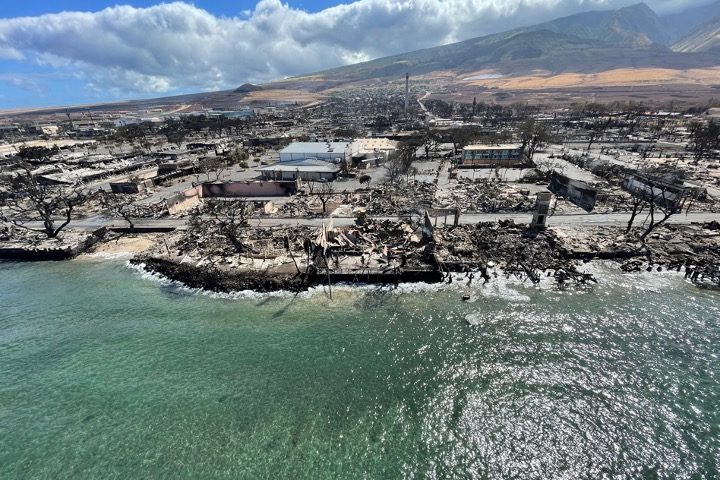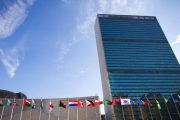
The catastrophic wildfires on Maui have spurred many to speculate on what caused such a tragedy on an otherwise lush tropical island. And, of course, many in the climate cult are simply closing their eyes, covering their ears, and shouting that climate change is the cause of this tragedy, and that everyone of us with our use of fossil fuels is personally to blame.
As of this writing, at least 93 are dead and the community of Lahaina lies in smoldering ruins as firefighters struggle to contain blazes on the island. People have been stunned to hear about a wildfire, of all things, devastating a tropical paradise. Such things are only supposed to occur in dry areas such as the American West or Australia — not on a lush tropical island.
And many are blaming climate change, perhaps not for the fires themselves but for leading to conditions that could allow such a conflagration to occur.
Climate change is “leading to these unpredictable or unforeseen combinations that we’re seeing right now and that are fueling this extreme fire weather,” Kelsey Copes-Gerbitz, a postdoctoral researcher said. “What these … catastrophic wildfire disasters are revealing is that nowhere is immune to the issue.”
Officials in Hawaii pleaded ignorance when asked why more wasn’t done to get people out of the fire’s path.
“We’ve never experienced a wildfire that affected a city like this, so this is something we’ve not experienced before,” said Governor Josh Green.
“We have experienced wildfires across the state and they’ve been tragic, but usually tragic in open space,” Green added. So, they knew wildfires were a possibility, they just didn’t know they were possible in places where people resided?
“The Lahaina tragedy was very difficult to anticipate, especially because it came in the night with high winds. But that does not mean that we won’t do everything we can in the future to stop this,” the governor concluded.
Maui, and more specifically Lahaina, was never “immune” to such a situation. It was also a possibility that Hawaii’s state government knew about, but did little to address. Elizabeth Pickett, co-executive director of Hawaii Wildfire Management, was one of those people who warned them.
Much more could have been done to mitigate the disaster, Pickett said.
“We keep hearing from certain elected officials and other people being quoted in the media, ‘we had no idea, this is unprecedented,’” Pickett explained. “But actually, those of us in the wildfire community, meaning our fire agencies, our forestry natural resource management community, we have long been working to increase our risk reduction efforts.”
Back in 2014, nearly a decade ago, Pickett co-authored the Western Maui Community Wildfire Protection Plan. In that report, the overall fire risk assessment for the entire Lahaina area was listed as “extreme.”
“We know there’s high risk. We know the science, we have the data, we’ve done the assessments, we have the community programs in place,” Pickett said. “It might not have been 100% preventable, but it could have been mitigated. It could have been lessened.”
So, while Governor Green, a Democrat, complains that the state had never “experienced a wildfire that affected a city” before, the report shows that he should have at least been aware of the possibility.
That foreknowledge, and his government’s utter failure to do anything about it, didn’t stop Green from blaming climate change for the tragedy.
“As we rebuild, we will have to take into consideration a lot more fire safety,” the governor said. “This is going to be a priority. Climate change is here, and it’s affecting the islands. And I think that’s what we’re seeing now with this fire.”
Instead of truly investigating the issue and the Hawaiian government’s culpability in it, climate alarmists are simply pinning the blame on climate change.
The Associated Press, which dispenses climate propaganda in part with millions of dollars from The Rockefeller Foundation, the William and Flora Hewlett Foundation, and Quadrivium, also used the tragedy to toot the “climate emergency” horn.
“Climate change not only increases the fire risk by driving up temperatures, but also makes stronger hurricanes more likely. In turn, those storms could fuel stronger wind events like the one behind the Maui fires,” the AP reported.
But when a climate realist assesses the situation, anthropogenic climate change plays little — if any — role in the tragic Maui wildfires.
“Climate change was not a factor,” Dr. H. Sterling Burnett, a climate scientist with the Heartland Institute, told The New American. “The modest background warming did not cause the present dryness … nor did it cause poor land management, nor did it spark the fire, nor did it cause the winds from a hurricane, nor, perhaps most importantly, did it cause the government to not prepare to fight such fires with the huge fuel buildup it allowed, or decide not to set off the island-wide alarm system of horns to warn people once the fires started.”
“People blaming climate change for Maui’s tragic fire and large loss of life are just alarmist opportunists, grotesquely dancing on the smoldering bodies of those whose lives were lost, trying to score political points. It is sick. No restriction on fossil fuel emissions would have prevented this terrible event,” Burnett concluded.
Unfortunately, simply blaming climate change is so much easier than actually looking at the real reasons why a tragedy such as the Maui wildfires might have happened. And in Governor Green’s case, it’s much more politically expedient. After all, why take responsibility for actions you might have taken to prevent the deaths of at least 93 people when you can blame the all-purpose bogeyman of climate change?



